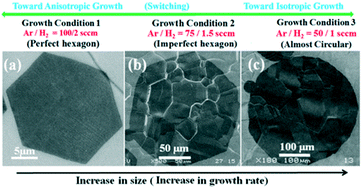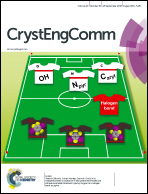Switching isotropic and anisotropic graphene growth in a solid source CVD system†
Abstract
Controlling the isotropic and anisotropic graphene growth in a chemical vapor deposition (CVD) process is a critical aspect to understand the growth dynamics for synthesizing large-area single crystals. Here, we reveal the effect of gas flow and controllability on isotropic and anisotropic graphene growth using a solid carbon source-based atmospheric pressure CVD method. It was found that the growth rate of round-shaped crystals (isotropic growth) was much higher than that of hexagonal crystals (anisotropic growth). The average growth speed increased from 0.276 μm min−1 to 1.89 μm min−1 by switching from hexagonal to circular domain growth in the CVD process. It was also found that there was no significant difference in the quality of graphene crystals when switching the growth from anisotropic to isotropic. Understanding the growth rate of round and hexagonal-shaped crystals can be critical to achieve faster growth of large single crystals. Again, the mixed edge structures (armchair and zigzag) in round-shaped graphene crystals without a fixed orientation unlike hexagonal crystals provide a better chance of seamless merging. Our findings can be significant in understanding the formation of isotropic and anisotropic graphene domains, their growth rate and quality for synthesizing large-area single crystals.



 Please wait while we load your content...
Please wait while we load your content...